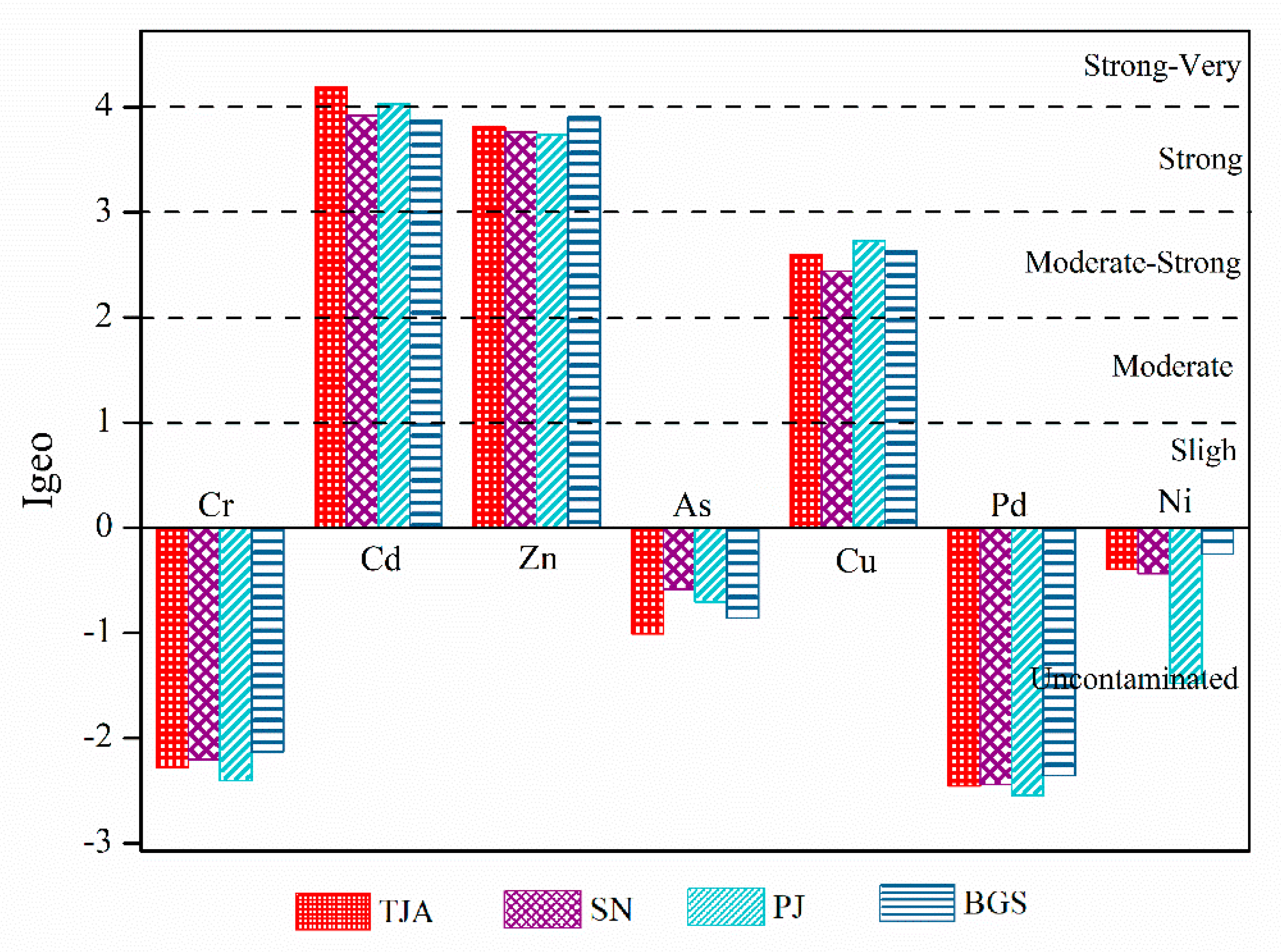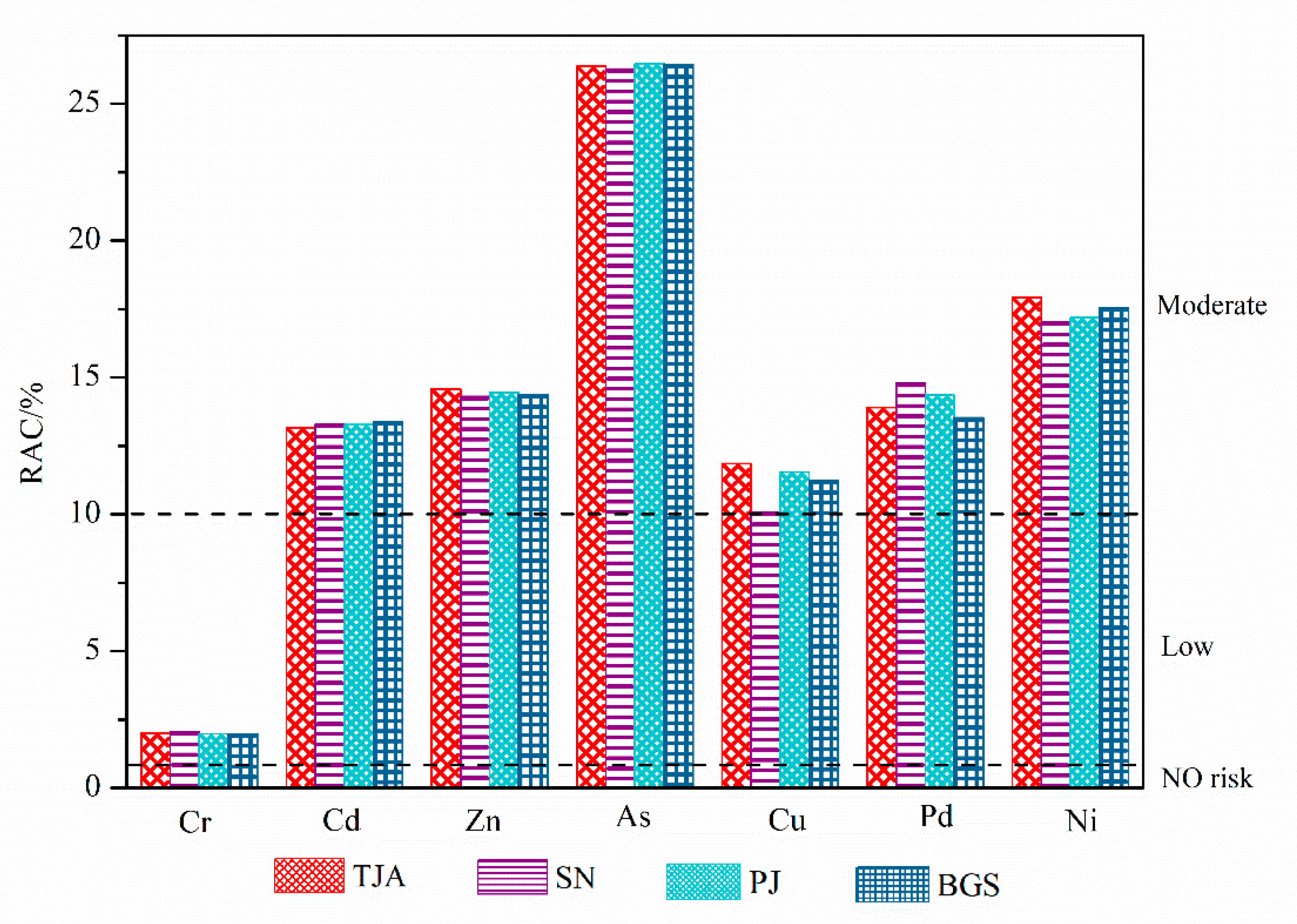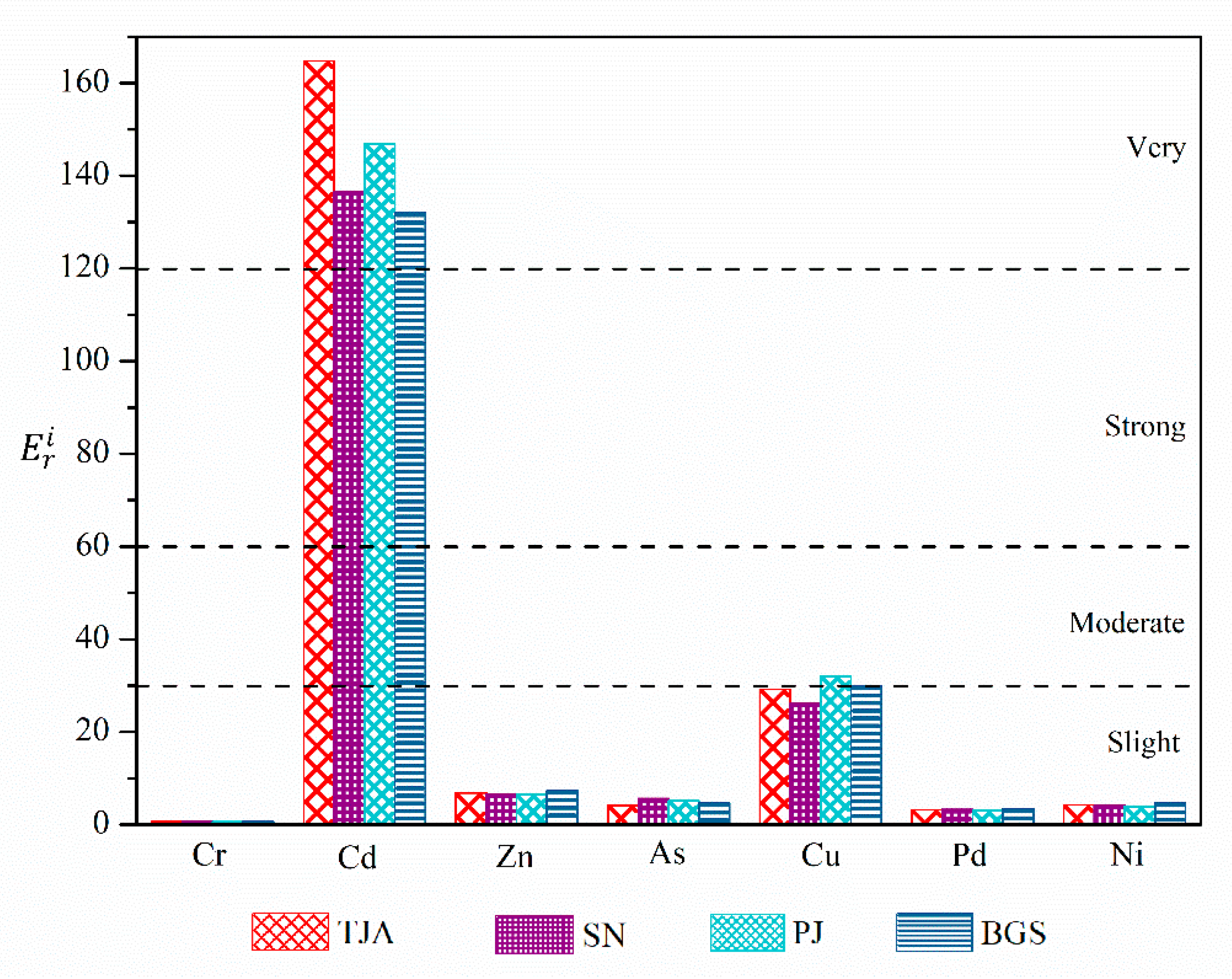Speciation Characteristics and Ecological Risk Assessment of Heavy Metals in Municipal Sludge of Huainan, China
Abstract
:1. Introduction
2. Materials and Methods
2.1. Sample Collection
2.2. Sample Analysis
2.3. Contamination Degree and Risk Analysis
2.3.1. Geo-Accumulation Index (Igeo) Method
2.3.2. Mobility and Availability of Heavy Metals Assessment Method
2.3.3. Potential Ecological Risk Assessment of Heavy Metals
3. Results and Discussion
3.1. Physical and Chemical Characteristics of Sludge
3.2. Content Characteristics of Heavy Metals
3.3. Speciation Patterns of Heavy Metals
- Cr: Residual > Reducible > Organic > Carbonate > Exchangeable
- Ni: Residual > Organic > Reducible > Carbonate > Exchangeable
- Pb: Residual > Organic > Reducible > Carbonate > Exchangeable
- Cd: Reducible > Organic > Carbonate >Residual > Exchangeable
- Cu: Organic > Reducible > Residual > Exchangeable > Carbonate
- Zn: Reducible > Organic > Carbonate > Residual > Exchangeable
- As: Organic > Residual > Carbonate > Reducible > Exchangeable
3.4. Ecological Risk Assessment of Heavy Metal Pollution in Sludge
3.4.1. Risk Assessment by the Geo-Accumulation Index
3.4.2. Mobility and Availability of Heavy Metals Assessment
3.4.3. Potential Ecological Risk Assessment of Heavy Metals
4. Conclusions
Author Contributions
Funding
Acknowledgments
Conflicts of Interest
References
- Alipour, M.; Asadi, H.; Chen, C.; Rashti, M.R. Bioavailability and eco-toxicity of heavy metals in chars produced from municipal sewage sludge decreased during pyrolysis and hydrothermal carbonization. Ecol. Eng. 2021, 162, 10673. [Google Scholar] [CrossRef]
- Chen, G.; Zhang, R.; Guo, X.; Wu, W.; Guo, Q.; Zhang, Y.; Yan, B. Comparative evaluation on municipal sewage sludge utilization processes for sustainable management in Tibet. Sci. Total Environ. 2021, 765, 142676. [Google Scholar] [CrossRef] [PubMed]
- Wang, F.; Yin, Z.; Liu, Y.; Sun, H.; Zhu, H.; Chen, H.; Zhang, K. Changes and release risk of typical pharmaceuticals and personal care products in sewage sludge during hydrothermal carbonization process. Chemosphere 2021, 284, 131313. [Google Scholar] [CrossRef]
- Cai, Q.Y.; Mo, C.H.; Wu, Q.T.; Zeng, Q.Y.; Katsoyiannis, A. Concentration and speciation of heavy metals in six different sewage sludge-composts. J. Hazard. Mater. 2007, 147, 1063–1072. [Google Scholar] [CrossRef]
- Wu, B.; Dai, X.; Chai, X. Critical review on dewatering of sewage sludge: Influential mechanism, conditioning technologies and implications to sludge re-utilizations. Water Res. 2020, 180, 115912. [Google Scholar] [CrossRef]
- Dai, J.; Chen, L.; Zhao, J.; Ma, N. Characteristics of sewage sludge and distribution of heavy metal in plants with amendment of sewage sludge. J. Environ. Sci. 2006, 18, 1094–1100. [Google Scholar] [CrossRef]
- Chagas, J.K.M.; Figueiredo, C.C.; da Silva, J.; Paz-Ferreiro, J. The residual effect of sewage sludge biochar on soil availability and bioaccumulation of heavy metals: Evidence from a three-year field experiment. J. Environ. Manag. 2021, 279, 111824. [Google Scholar] [CrossRef]
- Hei, L.; Jin, P.; Zhu, X.; Ye, W.; Yang, Y. Characteristics of speciation of heavy metals in municipal sewage sludge of Guangzhou as fertilizer. Procedia Environ. Sci. 2016, 31, 232–240. [Google Scholar] [CrossRef] [Green Version]
- Zheng, G.; Yu, B.; Wang, Y.; Ma, C.; Chen, T. Fate and biodegradation characteristics of triclocarban in wastewater treatment plants and sewage sludge composting processes and risk assessment after entering the ecological environment. J. Hazard. Mater. 2021, 412, 125270. [Google Scholar] [CrossRef]
- Khadhar, S.; Sdiri, A.; Chekirben, A.; Azouzi, R.; Charef, A. Integration of sequential extraction, chemical analysis and statistical tools for the availability risk assessment of heavy metals in sludge amended soils. Environ. Pollut. 2020, 263, 114543. [Google Scholar] [CrossRef]
- Ignatowicz, K. The impact of sewage sludge treatment on the content of selected heavy metals and their fractions. Environ. Res. 2017, 156, 19–22. [Google Scholar] [CrossRef]
- Strandberg, A.; Skoglund, N.; Thyrel, M. Morphological characterisation of ash particles from co-combustion of sewage sludge and wheat straw with X-ray microtomography—ScienceDirect. Waste Manag. 2021, 135, 30–39. [Google Scholar] [CrossRef] [PubMed]
- Chen, Y.; Gui, H.; Xia, Z.; Chen, X.; Zheng, L. Thermochemical and toxic element behavior during co-combustion of coal and municipal sludge. Molecules 2021, 26, 4170. [Google Scholar] [CrossRef]
- Liu, J.; Sun, S. Total concentrations and different fractions of heavy metals in sewage sludge from Guangzhou, China. Trans. Nonferrous Met. Soc. China 2013, 23, 2397–2407. [Google Scholar] [CrossRef]
- Qi, G.; Jia, Y.; Liu, W.; Wei, Y.; Du, B.; Fang, W.; Guo, Y.; Guo, F.; Wu, Y.; Zou, Q.; et al. Leaching behavior and potential ecological risk of heavy metals in Southwestern China soils applied with sewage sludge compost under acid precipitation based on lysimeter trials. Chemosphere 2020, 249, 126212. [Google Scholar] [CrossRef]
- Zhao, L.; Yu, R.; Yan, Y.; Cheng, Y.; Huang, H. Bioaccessibility and provenance of heavy metals in the park dust in a coastal city of southeast China. Appl. Geochem. 2020, 123, 104798. [Google Scholar] [CrossRef]
- Yang, T.; Huang, H.-J.; Lai, F.-Y. Pollution hazards of heavy metals in sewage sludge from four wastewater treatment plants in Nanchang, China. Trans. Nonferrous Met. Soc. China 2017, 27, 2249–2259. [Google Scholar] [CrossRef]
- Yuan, X.; Huang, H.; Zeng, G.; Li, H.; Wang, J.; Zhou, C.; Zhu, H.; Pei, X.; Liu, Z.; Liu, Z. Total concentrations and chemical speciation of heavy metals in liquefaction residues of sewage sludge. Bioresour. Technol. 2011, 102, 4104–4110. [Google Scholar] [CrossRef]
- Tessier, A.P.G.C.; Campbell, P.G.; Bisson, M.J.A.C. Sequential extraction procedure for the speciation of particulate trace metals. Anal. Chem. 1979, 51, 844–851. [Google Scholar] [CrossRef]
- Li, B.; Ding, S.; Fan, H.; Ren, Y. Experimental investigation into the effect of pyrolysis on chemical forms of heavy metals in Sewage Sludge Biochar (SSB), with brief ecological risk assessment. Materials 2021, 14, 447. [Google Scholar] [CrossRef]
- Fu, B.; Liu, G.; Mian, M.M.; Sun, M.; Wu, D. Characteristics and speciation of heavy metals in fly ash and FGD gypsum from Chinese coal-fired power plants. Fuel 2019, 251, 593–602. [Google Scholar] [CrossRef]
- Ji, Z.; Zhang, Y.; Zhang, H.; Huang, C.; Pei, Y. Fraction spatial distributions and ecological risk assessment of heavy metals in the sediments of Baiyangdian Lake. Ecotoxicol. Environ. Saf. 2019, 174, 417–428. [Google Scholar] [CrossRef]
- Smith, S.R. A critical review of the bioavailability and impacts of heavy metals in municipal solid waste composts compared to sewage sludge. Environ. Int. 2009, 35, 142–156. [Google Scholar] [CrossRef] [PubMed]
- Hamdy, E.N.; Abdelbaset, S.S.; Mohamed, A.W.; Said, N.; Mahmoud, M.; Al-Kahtany, K. Contamination and ecological risk assessment of heavy metals pollution from the Shalateen coastal sediments, Red Sea, Egypt. Mar. Pollut. Bull. 2019, 144, 167–172. [Google Scholar]
- Hu, Y.; You, M.; Liu, G.; Dong, Z. Characteristics and potential ecological risks of heavy metal pollution in surface soil around coal-fired power plant. Environ. Earth Sci. 2021, 80, 566. [Google Scholar] [CrossRef]
- Shou, Z.; Feng, C.; Yang, Y.; Niu, J.; Shen, Z. Risk assessment of sedimentary metals in the Yangtze Estuary: New evidence of the relationships between two typical index methods. J. Hazard. Mater. 2012, 241, 164–172. [Google Scholar]
- Pejman, A.; Nabi Bidhendi, G.; Ardestani, M.; Saeedi, M.; Baghvand, A. Fractionation of heavy metals in sediments and assessment of their availability risk: A case study in the northwestern of Persian Gulf. Mar. Pollut. Bull. 2017, 114, 881–887. [Google Scholar] [CrossRef] [PubMed]
- Wang, P.; Zhang, L.; Lin, X.; Yan, J.; Zhang, P.; Zhao, B.; Zhang, C.; Yu, Y. Spatial distribution, control factors and sources of heavy metal in the surface sediments of Fudu Estuary waters, East Liaodong Bay, China. Mar. Pollut. Bull. 2020, 156, 111279. [Google Scholar] [CrossRef]
- The Ministry of Commerce of the People’s Republic of China; Ministry of Rural and Urban Construction of the People’s Republic of China. GB CJ/T 221-2005 Determination Method for Municipal Sludge in Wastewater Treatment Plant[S]. 2002. Available online: https://www.antpedia.com/standard/5035627.html (accessed on 6 August 2021). (In Chinese)
- Muller, G. Index of geoaccumulation in sediments of the Rhine River. Geojournal 1969, 2, 109–118. [Google Scholar]
- Wang, J.; Liu, G.; Lu, L.; Zhang, J.; Liu, H. Geochemical normalization and assessment of heavy metals (Cu, Pb, Zn, and Ni) in sediments from the Huaihe River, Anhui, China. Catena 2015, 129, 30–38. [Google Scholar] [CrossRef]
- Perin, G.; Craboledda, L.; Lucchese, M.; Cirillo, R.; Dotta, L.; Zanette, M.; Orio, A. Heavy metal speciation in the sediments of northern Adriatic Sea. A new approach for environmental toxicity determination. Heavy Met. Environ. 1985, 2, 454–456. [Google Scholar]
- Hakanson, L. An ecological risk index for aquatic pollution control—A sedimentological approach. Water Res. 1980, 14, 975–1001. [Google Scholar] [CrossRef]
- Du, Q.; Shi, X.; Ding, Y.; Lanbao, Z. Potential ecological risk and health risk assessment of heavy metals in a sewage treatment plant in Bengbu. J. Chang. Norm. Univ. 2020, 39, 171–178. (In Chinese) [Google Scholar]
- Environmental Protection Administration (EPA), China; Ministry of Rural and Urban Construction, China. GB 18918—2002 Discharge Standards of Pollutants for Municipal Wastewater Treatment Plant[S]. 2002. Available online: https://www.antpedia.com/standard/533167.html (accessed on 10 August 2021). (In Chinese)
- Ma, X.; Weng, H.; Zhang, J. Regional characteristics and trend of heavy metals and nutrients of sewage sludge in China. China Environ. Sci. 2011, 31, 1306–1313. (In Chinese) [Google Scholar]
- Meng, G.; Zha, T.; Zhang, X.; Liu, Z.; Guangrui, S.U. Heavy metal pollution characteristics and ecological risk assessment of the sludge from wastewater treatment plants in Beijing. Ecol. Environ. Sci. 2017, 26, 1883–1891. [Google Scholar]
- Guo, G.H.; Chen, T.B.; Yang, J.; Zheng, G.; Ding, G. Regional distribution characteristics and variation of heavy metals in sewage sludge of China. Huanjing Kexue Xuebao/Acta Sci. Circumstantiae 2014, 34, 2455–2461. (In Chinese) [Google Scholar]
- Min, L.; Jianguo, Y.; Zhenyi, M.; Yu, Z.; Zhan, M.; Jinjian, D. Pollution and morphological characteristics of heavy netals in municipal sludge from Hangzhou. Environ. Sci. Technol. 2020, 43, 54–58. [Google Scholar]
- Geng, Y.M.; Zhang, C.B.; Zhang, Y.; Huang, D.D.; Yan, S.X.; Sun, T.F.; Cheng, L.; Wang, J.; Mao, Y.X. Speciation and ecological risk assessment of heavy metal(loid)s in the municipal sewage sludge of China. Environ. Sci. 2021, 4, 4834–4843. (In Chinese) [Google Scholar]





| Sample | Capacity/ (m3·day−1) | Wastewater Treatment Technology | Sewage Type | Sludge Dewatering Technique |
|---|---|---|---|---|
| TJA (Tianjiaan) | 1.00 × 105 | Oxidation ditch, SBR | Domestic sewage | Belt filter |
| SN (Shannan) | 5.00 × 104 | Oxidation ditch, SBR | Domestic sewage | Rotary press filter |
| PJ (Panji) | 4.00 × 104 | Oxidation ditch, SBR | Domestic sewage | Belt filter |
| BGS (Bagongshan) | 1.00 × 105 | A2/O | Domestic sewage | Belt filter |
| Geo-Accumulation Index (Igeo) | Classification of RAC Risk Assessment | Grading Standards of Potential Ecological Risk | |||||
|---|---|---|---|---|---|---|---|
| Geo-Accumulation index (Igeo) | Degree | Risk Level | Evaluation Index Range | Risk Level | RI | Risk Level | |
| Igeo < 0 | 0 | Uncontaminated | RAC < 1% | No risk | < 30 | RI < 100 | Slight |
| 0 ≤ Igeo < 1 | 1 | Slight | 1% < RAC ≤ 10% | Low | 30 ≤ < 60 | 100 ≤ RI< 200 | Moderate |
| 1 ≤ Igeo < 2 | 2 | Moderate | 10% < RAC ≤ 30% | Moderate | 60 ≤ < 120 | 200 ≤ RI< 400 | Strong |
| 2 ≤ Igeo < 3 | 3 | Moderate–Strong | 30% < RAC ≤ 50% | High | 120 ≤ < 240 | RI ≥ 400 | Very strong |
| 3 ≤ Igeo < 4 | 4 | Strong | RAC > 50% | Extremely high | ≥ 240 | Extremely strong | |
| 4 ≤ Igeo < 5 | 5 | Strong–Very strong | |||||
| Igeo ≥ 5 | 6 | Extremely Strong | |||||
| Sample | PH | Moisture Content/ (%) | EC/ (μs·cm−1) | Organic Matter/ (g·kg−1) | TN/ (g·kg−1) | TP/ (g·kg−1) | TK/ (g·kg−1) | TN+TP+TK/ (g·kg−1) |
|---|---|---|---|---|---|---|---|---|
| TJA | 6.83 | 78.16 | 980 | 324.15 | 24.13 | 6.92 | 7.23 | 38.28 |
| SN | 6.92 | 82.12 | 1200 | 287.69 | 22.54 | 8.14 | 7.51 | 38.19 |
| PJ | 7.16 | 79.32 | 1300 | 316.53 | 27.18 | 10.17 | 6.96 | 44.31 |
| BGS | 6.54 | 82.34 | 1060 | 352.46 | 32.16 | 9.18 | 7.08 | 48.42 |
| Mean value | 6.86 | 80.49 | 1135 | 320.21 | 26.50 | 8.60 | 7.20 | 42.30 |
| CJ/T 309-2009 | 5.5–9.0 | ≤60 | - | ≥200 | - | - | - | ≥3 |
| As | Cd | Cr | Cu | Ni | Pb | Zn | Literatures | |
|---|---|---|---|---|---|---|---|---|
| TJA | 8.76 | 2.82 | 67.92 | 236.52 | 53.68 | 44.53 | 652.36 | |
| SN | 12.13 | 2.37 | 64.53 | 218.79 | 50.16 | 43.62 | 634.18 | |
| PJ | 10.87 | 2.69 | 58.24 | 262.48 | 49.57 | 39.84 | 587.69 | |
| BGS | 9.48 | 2.39 | 71.86 | 243.51 | 56.26 | 46.83 | 681.72 | |
| Average | 10.31 | 2.57 | 65.64 | 240.33 | 52.42 | 43.71 | 638.99 | |
| National emission standard | 75 | 20 | 1000 | 1500 | 200 | 1000 | 3000 | GB 18918-2002 |
| Agricultural standard limit of sludge (class A) | 30 | 3 | 500 | 500 | 100 | 300 | 1500 | GJ/T 309-2018 |
| Landscaping limit (acid soil) | 75 | 5 | 600 | 800 | 100 | 300 | 2000 | GB/T 23486-2009 |
| Mean in China | 7.18 | 222 | 533 | 79.1 | 115 | 1270 | [36] | |
| Beijing | 11.5 | 2.1 | 97.5 | 182.5 | 44.9 | 65.3 | 729.6 | [38] |
| Guang Zhou | 1.4 | 129.1 | 164.2 | 49.4 | 55.9 | 340.4 | [14] | |
| Hang Zhou | 14.7 | 1.4 | 46.6 | 89.1 | 91.9 | 48 | 380.3 | [39] |
Publisher’s Note: MDPI stays neutral with regard to jurisdictional claims in published maps and institutional affiliations. |
© 2021 by the authors. Licensee MDPI, Basel, Switzerland. This article is an open access article distributed under the terms and conditions of the Creative Commons Attribution (CC BY) license (https://creativecommons.org/licenses/by/4.0/).
Share and Cite
You, M.; Hu, Y.; Yan, Y.; Yao, J. Speciation Characteristics and Ecological Risk Assessment of Heavy Metals in Municipal Sludge of Huainan, China. Molecules 2021, 26, 6711. https://doi.org/10.3390/molecules26216711
You M, Hu Y, Yan Y, Yao J. Speciation Characteristics and Ecological Risk Assessment of Heavy Metals in Municipal Sludge of Huainan, China. Molecules. 2021; 26(21):6711. https://doi.org/10.3390/molecules26216711
Chicago/Turabian StyleYou, Mu, Yunhu Hu, Yule Yan, and Jie Yao. 2021. "Speciation Characteristics and Ecological Risk Assessment of Heavy Metals in Municipal Sludge of Huainan, China" Molecules 26, no. 21: 6711. https://doi.org/10.3390/molecules26216711





